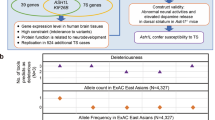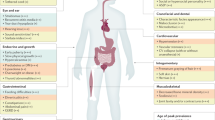Abstract
Tourette syndrome (TS) is a childhood-onset complex neurobiological disorder characterized by a combination of persistent motor and vocal tics and frequent presence of other neuropsychiatric comorbidities. TS shares the fate of other complex disorders, where the genetic etiology is largely unknown, and identification of susceptibility genes through linkage and association studies has been complicated due to inherent difficulties such as no clear mode of inheritance, genetic heterogeneity, and apparently incomplete penetrance. Positional cloning through mapping of disease-related chromosome rearrangements has been an efficient tool for the cloning of disease genes in several Mendelian disorders and in a number of complex disorders. Through cytogenetic investigation of 205 TS patients, we identified three possibly disease-associated chromosome rearrangements rendering this approach relevant in chasing TS susceptibility genes.
Similar content being viewed by others
References
Freeman RD, Fast DK, Burd L, Kerbeshian J, Robertson MM, Sandor P (2000) An international perspective on Tourette syndrome: selected findings from 3,500 individuals in 22 countries. Dev Med Child Neurol 42:436–447
Robertson MM, Eapen V, Cavanna AE (2009) The international prevalence, epidemiology, and clinical phenomenology of Tourette syndrome: a cross-cultural perspective. J Psychosom Res 67:475–483
Paschou P (2013) The genetic basis of Gilles de la Tourette Syndrome. Neurosci Biobehav Rev. doi:10.1016/j.neubiorev.2013.01.016
Tommerup N (1993) Mendelian cytogenetics. Chromosome rearrangements associated with Mendelian disorders. J Med Genet 30:713–727
Tümer Z, Chelly J, Tommerup N, Ishikawa-Brush Y, Tønnesen T, Monaco AP, Horn N (1992) Characterization of a 1.0 Mb YAC contig spanning two chromosome breakpoints related to Menkes disease. Hum Mol Genet 1:483–489
Chelly J, Tümer Z, Tønnesen T, Petterson A, Ishikawa-Brush Y, Tommerup N, Horn N, Monaco AP (1993) Isolation of a candidate gene for Menkes disease that encodes a potential heavy metal binding protein. Nat Genet 3:14–19
Millar JK, Wilson-Annan JC, Anderson S, Christie S, Taylor MS, Semple CA, Devon RS, St Clair DM, Muir WJ, Blackwood DH, Porteous DJ (2000) Disruption of two novel genes by a translocation co-segregating with schizophrenia. Hum Mol Genet 9:1415–1423
Blackwood DH, Fordyce A, Walker MT, St Clair DM, Porteous DJ, Muir WJ (2001) Schizophrenia and affective disorders—cosegregation with a translocation at chromosome 1q42 that directly disrupts brain-expressed genes: clinical and P300 findings in a family. Am J Hum Genet 69:428–433
Lai CS, Fisher SE, Hurst JA, Levy ER, Hodgson S, Fox M, Jeremiah S, Povey S, Jamison DC, Green ED, Vargha-Khadem F, Monaco AP (2000) The SPCH1 region on human 7q31: genomic characterization of the critical interval and localization of translocations associated with speech and language disorder. Am J Hum Genet 67:357–368
Lai CS, Fisher SE, Hurst JA, Vargha-Khadem F, Monaco AP (2001) A forkhead-domain gene is mutated in a severe speech and language disorder. Nature 413:519–523
Abelson JF, Kwan KY, O'Roak BJ, Baek DY, Stillman AA, Morgan TM, Mathews CA, Pauls DL, Rasin MR, Gunel M, Davis NR, Ercan-Sencicek AG, Guez DH, Spertus JA, Leckman JF, Dure LS 4th, Kurlan R, Singer HS, Gilbert DL, Farhi A, Louvi A, Lifton RP, Sestan N, State MW (2005) Sequence variants in SLITRK1 are associated with Tourette's syndrome. Science 310:317–320
Petek E, Windpassinger C, Vincent JB, Cheung J, Boright AP, Scherer SW, Kroisel PM, Wagner K (2001) Disruption of a novel gene (IMMP2L) by a breakpoint in 7q31 associated with Tourette syndrome. Am J Hum Genet 68:848–858
Verkerk AJ, Mathews CA, Joosse M, Eussen BH, Heutink P, Oostra BA, Tourette Syndrome Association International Consortium for Genetics (2003) CNTNAP2 is disrupted in a family with Gilles de la Tourette syndrome and obsessive compulsive disorder. Genomics 82:1–9
American Psychiatric Association (2000) Diagnostic and statistical manual text revision (DSM-IV-TR, 2000), 4th edn. American Psychiatric Association, Washington D.C
Debes NMM, Hjalgrim H, Skov L (2008) Validation of the presence of comorbidities in a Danish clinical cohort of children with Tourette syndrome. J Child Neurol 23:1017–1027
Xu J, Zwaigenbaum L, Szatmari P, Scherer SW (2004) Molecular cytogenetics of autism. Curr Genomics 5:347–364. doi:10.2174/1389202043349246
Aruga J, Mikoshiba K (2003) Identification and characterization of Slitrk, a novel neuronal transmembrane protein family controlling neurite outgrowth. Mol Cell Neurosci 24:117–129
Boghosian-Sell L, Comings DE, Overhauser J (1996) Tourette syndrome in a pedigree with a 7;18 translocation: identification of a YAC spanning the translocation breakpoint at 18q22.3. Am J Hum Genet 59:999–1005
Kroisel PM, Petek E, Emberger W, Windpassinger C, Wladika W, Wagner K (2001) Candidate region for Gilles de la Tourette syndrome at 7q31. Am J Med Genet 101:259–261
Patel C, Cooper-Charles L, McMullan DJ, Walker JM, Davison V, Morton J (2011) Translocation breakpoint at 7q31 associated with tics: further evidence for IMMP2L as a candidate gene for Tourette syndrome. Eur J Hum Genet 19:634–639
Petek E, Schwarzbraun T, Noor A, Patel M, Nakabayashi K, Windpassinger C, Stamenkovic M, Robertson MM, Aschauer HN, Gurling HM, Kroisel PM, Wagner K, Scherer SW, Vincent JB (2007) Molecular and genomic studies of IMMP2L and mutation screening in autism and Tourette syndrome. Mol Genet Genomics 277:71–81
Poot M, Beyer V, Schwaab I, Damatova N, Van't Slot R, Prothero J, Holder SE, Haaf T (2010) Disruption of CNTNAP2 and additional structural genome changes in a boy with speech delay and autism spectrum disorder. Neurogenetics 11:81–89
Belloso JM, Bache I, Guitart M, Caballin MR, Halgren C, Kirchhoff M, Ropers HH, Tommerup N, Tümer Z (2007) Disruption of the CNTNAP2 gene in a t(7;15) translocation family without symptoms of Gilles de la Tourette syndrome. Eur J Hum Genet 15:711–713
Devor EJ, Magee HJ (1999) Multiple childhood behavioral disorders (Tourette syndrome, multiple tics, ADD and OCD) presenting in a family with a balanced chromosome translocation (t1;8)(q21.1;q22.1). Psychiatr Genet 9:149–151
Matsumoto N, David DE, Johnson EW, Konecki D, Burmester JK, Ledbetter DH, Weber JL (2000) Breakpoint sequences of an 1;8 translocation in a family with Gilles de la Tourette syndrome. Eur J Hum Genet 8:875–883
Simonic I, Gericke GS, Ott J, Weber JL (1998) Identification of genetic markers associated with Gilles de la Tourette syndrome in an Afrikaner population. Am J Hum Genet 63:839–846
Simonic I, Nyholt DR, Gerick GS, Gordon D, Matsumoto N, Ledbetter DH, Ott J, Weber JL (2001) Further evidence for linkage of Gilles de la Tourette syndrome (GTS) susceptibility loci on chromosomes 2p11, 8q22, and 11q23-24 in South African Afrikaners. Am J Med Genet 105:163–167
Brett PM, Curtis D, Robertson MM, Dahlitz M, Gurling HM (1996) Linkage analysis and exclusion of regions of chromosome 3 and 8 in Gilles de la Tourette syndrome following the identification of a balanced reciprocal translocation 46, XY, t(3;8)(p21.3;q24.1) in a case of Tourette syndrome. Psychiatr Genet 6:99–105
Knight S, Coon H, Johnson M, Leppert MF, Camp NJ, McMahon WM, Tourette Syndrome Association International Consortium for Genetics (2010) Linkage analysis of Tourette syndrome in a large Utah pedigree. Am J Med Genet B Neuropsychiatr Genet 153B:656–662
State MW, Greally JM, Cuker A, Bowers PN, Henegariu O, Morgan TM, Gunel M, DiLuna M, King RA, Nelson C, Donovan A, Anderson GM, Leckman JF, Hawkins T, Pauls DL, Lifton RP, Ward DC (2003) Epigenetic abnormalities associated with a chromosome 18(q21-q22) inversion and a Gilles de la Tourette syndrome phenotype. Proc Natl Acad Sci U S A 8:4684–4689
Cuker A, State MW, King RA, Davis N, Ward DC (2004) Candidate locus for Gilles de la Tourette syndrome/obsessive compulsive disorder/chronic tic disorder at 18q22. Am J Med Genet 130A:37–39
Donnai D (1987) Gene location in Tourette syndrome. Lancet 1:627
Sundaram SK, Hug AM, Wilson BJ, Chugani HT (2010) Tourette syndrome is associated with recurrent exonic copy number variants. Neurology 74:1583–1590
Fernandez TV, Sanders SJ, Yurkiewicz IR, Ercan-Sencicek AG, Kim YS, Fishman DO, Raubeson MJ, Song Y, Yasuno K, Ho WS, Bilquvar K, Glessner J, Chu SH, Leckman JF, King RA, Gilbert DL, Heiman GA, Tischfield JA, Hoekstra PJ, Devlin B, Hakonarson H, Mane SM, Günel M, State MW (2012) Rare copy number variants in Tourette syndrome disrupt genes in histaminergic pathways and overlap with autism. Biol Psychiatry 71:392–402
Nag A, Bochukova EG, Kremeyer B, Campbell DD, Muller H, Valencia-Duarte AV, Cardona J, Rivas IC, Mesa SC, Cuartas M, Garcia J, Bedoya G, Cornejo W, Herrera LD, Romero R, Fournier E, Reus VI, Lowe TL, Farooqi IS, Tourette Syndrome Association International Consortium for Genetics, Mathews CA, McGrath LM, Yu D, Cook E, Wang K, Scharf JM, Pauls DL, Freimer NB, Plagnol V, Ruiz-Linares A (2013) CNV analysis in Tourette syndrome implicates large genomic rearrangements in COL8A1 and NRXN1. PLoS One 8:e59061
Rossi E, Verri AP, Patricelli MG, Destefani V, Ricca I, Vetro A, Ciccone R, Giorda R, Toniolo D, Maraschio P, Zuffardi O (2008) A 12 Mb deletion at 7q33-q35 associated with autism spectrum disorders and primary amenorrhea. Eur J Med Genet 51:631–638
Bakkaloglu B, O'Roak BJ, Louvi A, Gupta AR, Abelson JF, Morgan TM, Chawarska K, Klin A, Ercan-Sencicek AG, Stillman AA, Tanriover G, Abrahams BS, Duvall JA, Robbins EM, Geschwind DH, Biedere T, Gunel M, Lifton RP, State MW (2008) Molecular cytogenetic analysis and resequencing of contactin associated protein-like 2 in autism spectrum disorders. Am J Hum Genet 82:165–173
Comings DE, Comings BG, Dietz G, Muhleman D, Okada TA, Ariana F, Simmer R, Stock D (1986) Evidence the Tourette syndrome gene is at 18q22.1. 17th International Congress of Human Genetics, Berlin; abstr part II:620.
Hooper SD, Johansson AC, Tellgren-Roth C, Stattin EL, Dahl N, Cavelier L, Feuk L (2012) Genome-wide sequencing for the identification of rearrangements associated with Tourette syndrome and obsessive-compulsive disorder. BMC Med Genet 13:123. doi:10.1186/1471-2350-13-123
Crawford FC, Ait-Ghezala G, Morris M, Sutcliffe MJ, Hauser RA, Silver AA, Mullan MJ (2003) Translocation breakpoint in two unrelated Tourette syndrome cases, within a region previously linked to the disorder. Hum Genet 113:154–161
Singh DN, Howe GL, Jordan HW, Hara S (1982) Tourette's syndrome in a black woman with associated triple X and 9p mosaicism. J Natl Med Assoc 74:675–682
Taylor LD, Krizman DB, Jankovic J, Hayani A, Steuber PC, Greenberg F, Fenwick RG, Caskey CT (1991) 9p monosomy in a patient with Gilles de la Tourette's syndrome. Neurology 41:1513–1515
Jankovic J, Deng H (2007) Candidate locus for chorea and tic disorders at 15q? Pediatr Neurol 37:70–73
Shelley BP, Robertson MM, Turk J (2007) An individual with Gilles de la Tourette syndrome and Smith-Magenis microdeletion syndrome: is chromosome 17p11.2 a candidate region for Tourette syndrome putative susceptibility genes? J Intellect Disabil Res 51:620–624
Dehning S, Riedel M, Müller N (2008) Father-to-son transmission of 6;17 translocation in Tourette's syndrome. Am J Psychiatry 165:1051–1052
Barabas G, Wardell B, Sapiro M, Matthews WS (1986) Coincident Down's and Tourette syndromes: three case reports. J Child Neurol 1:358–360
Robertson MM, Shelley BP, Dalwai S, Brewer C, Critchley H (2006) A patient with both Gilles de la Tourette's syndrome and chromosome 22q11 deletion syndrome: clue to the genetics of Gilles de la Tourette's syndrome? J Psychosom Res 61:365–368
Merskey H (1974) A case of multiple tics with vocalisation (partial syndrome of Gilles de la Tourette) and XYY karyotype. Br J Psychiatry 125:593–594
Acknowledgments
The study is supported by The Lundbeck Foundation (R24-A219), and BB is currently funded by a scholarship from the University of Copenhagen.
Author information
Authors and Affiliations
Corresponding author
Rights and permissions
About this article
Cite this article
Bertelsen, B., Debes, N.M., Hjermind, L.E. et al. Chromosomal rearrangements in Tourette syndrome: implications for identification of candidate susceptibility genes and review of the literature. Neurogenetics 14, 197–203 (2013). https://doi.org/10.1007/s10048-013-0372-y
Received:
Accepted:
Published:
Issue Date:
DOI: https://doi.org/10.1007/s10048-013-0372-y




